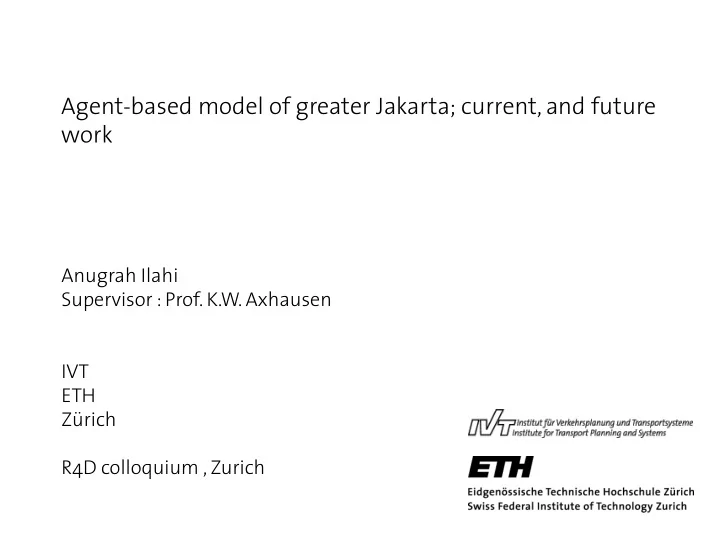

Agent-based model of greater Jakarta; current, and future work Anugrah Ilahi Supervisor : Prof. K.W. Axhausen IVT ETH Zürich R4D colloquium , Zurich
Introduction • Develop agent-based model in Greater Jakarta using MATSim • Integrated choice model and agent-based model • Explore the accessibility by public transport 2
Jakarta Now 3
Jakarta Now 4
MATSim loop 5
MATSim loop integrated with mode-choice model Mode-Choice Model x More info at: www.eqasim.org 6
Greater Jakarta Scenario Synthesis Two parts: • Supply (road network, public transport services) • Demand (synthetic population) 7
Creating Public Transport Network; OSM & GTFS Open Street Map • 472 thousand nodes • 1.2 million links Multimodal Transport • BRT • Buses • Rail • Microbus ( Angkot ) • Car • Motorcycle 8
Synthetic Population (1) • Population is synthesized using the data gathered by the Japan International Cooperation Agency (JICA) in 2009 (JICA, 2009), which includes 3% of Households • Synthetic agents are synthesized using Bayesian Network (BN) and Generalized Raking (GR) 9
Synthetic Population (2) Household data Data Joint/Fusion Individual data Geocoding location Fitting to Marginal data Population marginal Region by Age Synthesis using BN target approach using GR Marginal data Region by Gender Output Dataset of all variables needed 10
Choice Modelling (Parameter estimates) Mode Parameters Estimate β numberOfTransfers, PT. -0.170 β inVehicleTime, PT [min-1] -0.120 Public Transport β transferTime, PT [min-1] -0.048 β accessEgressTime, PT [min-1] -0.080 α Car 1.227 Car β travelTime, Car [min-1] -0.066 α MC 1.227 Motorcycle β travelTime, MC [min-1] -0.100 α walk 1.430 Walk β travelTime,walk [min-1] -0.141 β Cost Other -0.030 θ parkingSearchTime, Car [min] 4.000 θ accessEgressTime, Car [min] Calibration 4.000 θ accessEgressTime,MC [min] 2.000 11
Activities simulated in MATSim (1) Education Home Working 12
Activities simulated in MATSim (2) 13
Mode shares 4.4 Car 8.6 40.5 Motorcycle 41.6 24.1 Public Tranport 26.8 31 Non-Motorized Transport 30 0 5 10 15 20 25 30 35 40 45 MATSim JICA 14
Traffic Count comparison: MC on Thamrin St. 4500 4000 3500 3000 2500 2000 1500 1000 500 0 1 2 3 4 5 6 7 8 9 10 11 12 13 14 15 16 MATSim Counting 15
Traffic Count comparison: Cars on Thamrin St. 7000 6000 5000 4000 3000 2000 1000 0 1 2 3 4 5 6 7 8 9 10 11 12 13 14 15 16 16
Trip Distance Band Distance Trips Trips [%] Less than 1 km 105,372 7.72 1 - 5 km 514,413 37.67 5 - 10 km 300,938 22.04 10 - 20 km 248,785 18.22 20 - 30 km 95,119 6.97 More than 30 km 100,813 7.38 17
Accessibility
Conclusions • We use a novel approach that integrates choice modelling in MATSim • There is small difference of mode share between JICA and MATSim model • Number of motorcycles and cars in the MATSim model is higher than observed. • The accessibility is higher in the Greater Jakarta, and less so in agglomeration cities 19
Limitations • The model so far only based on mandatory activities (HWH and HSH) • Only 5% of population are simulated (1.1 million) • 1 iteration takes more than 1 hour • We use mode-choice model parameters estimated for Zurich, Switzerland (Jakarta RP/SP survey is on-going) 20
Future Work • Include mandatory and secondary activities based on our new survey “MOBILITY JAKARTA” in the model • Using choice model parameter of Greater Jakarta • Simulate emerging transportation • Online motorcycle taxi • Online car taxi • Urban Air Mobility • Policy recommendations for the government 21
Questions ? www.ivt.ethz.ch www.MATSim.org 22
Appendix 23
Mobility Jakarta Survey • RP Survey • SP Survey 24
RP : Mode share by distance 25
RP : Mode share by activity 26
RP: Travel Time and Distance by Mode 27
RP: Travel Time and Mode by Activities 28
RP : Travel Time and Cost by Mode 29
RP : Trip Chain Distribution Trip Chain Share of Trip Chain Share of Trip Chain Trip Chain h,w,l,w,l,w,h h,w,h 0.73% 39.12% h,w,l,w,l,w,l,w,h h,e,h 0.48% 22.70% h,w,s,h h,w,l,w,h 0.45% 13.66% h,er,w,l,h h,s,h 5.83% 0.34% h,w,er,h h,w,l,h 4.40% 0.32% h,w,s,w,h h,l,h 0.27% 3.53% h,w,l,w,l,h h,er,h 0.24% 1.97% h,s,w,l,h h,s,w,h 0.19% 1.32% h,er,w,h h 0.74% 0.18% Others h,e,l,h 0.74% 2.77% e = education er = errand h = home l = leisure s = shopping w = working 30
SP : Choices, Distance and Types of Respondent Variable Value Sample (%) Choice PT 21.00 Car 10.20 MC 41.00 Car taxi 2.10 MC taxi 6.20 Car ODT 3.30 MC ODT 9.40 UAM 3.00 Walk 3.70 Distance band 0-1.5 km 11.00 1.5-5 km 16.00 5-15 km 35.90 >15 km 37.20 Type of Driver to Jakarta 44.20 respondents Driver out of Jakarta 18.30 Non-driver in Jakarta 1050 Non-driver out of Jakarta 27.00 31
SP: Distance by Mode 32
RP: Types of Respondents by Mode 33
Recommend
More recommend